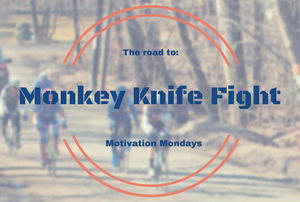If you read my last “Motivation Monday” you'll know I was somehow suckered into riding the Monkey Knife Fight in April. I'd suggest you read the previous column to learn a little more about the race itself. The short, short version of it is this: it's a spring classic, PA style. That means dirt roads, gravel, steep climbs, shitty weather and lots and lots of fun.
Since I've been suckered into this via a good buddy of mine (thanks again Nate…) I can't let him take me out to the middle of nowhere and leave me for dead. No sir. That's not an option.
This week, I'll explore a little of my training theory and what I'm going to do to get my butt in shape to actually finish this ride without breaking down and crying.
 Training For Dirt and Gravel
Training For Dirt and Gravel
True enough, MKF (that's Monkey Knife Fight because I'm lazy and don't want to write it out each time) is a dirt/gravel ride. True enough I've got a training program for gravel rides and races like MKF or Tour of the Battenkill. But I love to tinker. Most of you know that. You know that I'm always testing new fitness concepts and training programs, trying to build a better mousetrap for myself. And of course, that gets passed on to you as training programs and training articles.
In this case, I'm going to focus on a couple of specific things for this training program, and specifically this 2-month block of base training.
Muscular Endurance
When it comes to gravel rides, muscular endurance is going to be at a premium. All that dirt and gravel will add significant resistance to my tires, so I'll need every little bit of strength to push through. It's also a fairly hilly ride, with multiple climbs above 10% grade. Combine that with the rough surface and you've got a recipe for muscular endurance disaster.
You see, if you can't spin up those climbs (and you won't be able to: your rear wheel will spin out and you'll bog down) you'll have to gear down and grind it out. The more you try to do that, the more tension on your legs. The more tension on your legs, the more fatigue will set in. Once that fatigue sets in, you're done for.
To counteract that inevitable grind and the accompanying fatigue, I'm planning to do about 40% of my sweetspot and upper-end work as muscular endurance. That means any sweetspot intervals I do will be lower cadence. Most climbing intervals will be lower cadence with big pedal tension. Trust me, it'll pay off in a big way and I'll be able to grind out climbs all day long.
VO2 Max Fitness
Speaking of those steep climbs, I've got to get over them somehow. And no, I'm not going to switch to a compact despite the fact I STILL think they're the optimal gearing for your average rider. What can I say, I'm a stubborn bastard. What I'm going to do is work on building long form VO2 max power. If some of the climbs are going to top out at 10 minutes or less, longer form VO2 intervals are going to be the ticket to effectively get over them. I'll be aiming to start 8 minute VO2 type efforts around the middle of the base period once I get my legs back under me with some solid endurance capacity.
That being said, endurance capacity is going to be pretty important. Considering the ride is 65 miles, I'll need to handle about 3 and a half hours, right?
Endurance Capacity
3.5 hours in the saddle in early to mid-April is a pretty lofty goal. That's doubly true for a fast twitcher like myself. Honestly, if the world doesn't consist of laps, I'm not quite sure what to do with myself these days. But I digress.
Endurance capacity is going to be significantly important come April. To help enhance that, I'll be tossing extra endurance work into my program. Any recoveries from higher intensity intervals? That's endurance. Technique work, leg speed drills and such? That's endurance work. 10 minutes of warmup before jumping into a workout? That's also endurance. Any chance I get, I'll be keeping my intensity around 65%-75% of my FTP to stimulate that endurance adaptation.
What's (Zwift) London Got To Do With It?
So now, what's London got to do with it? No, not “what's love got to do with it”, I said London. Of course, I mean the Zwift London course. Of course.
Whatever.
The newest addition to the Zwift London course is a loop in the Surrey countryside that includes Leith Hill. That means we now have a Zwift option allowing us to ride a loop of shorter (read: 10 minutes or so) climbs on repeat. Like a mouse on a wheel, we can tackle the same climbs over and over and over again. It's essentially hill repeats, but with the added misery of sitting on your trainer!
Or not?
Well, maybe not. The new expansion of Leith Hill gives us a climb with some extended 10% or greater gradients. This is the perfect way to train for MKF, which also has several double-digit gradient climbs. It's also the perfect spot to knock out some longer VO2 max work. So, obviously, you can expect to see me doing hill repeats a few times on the London circuit. Between the muscular endurance work and the VO2 max work, I've got plenty to do.
And I've only got 4 months to get it done.
Shit.
I think I need to get on that bike…
Until next time, hopefully, these tips will inspire you and help you hit your early season goal. See you (virtually) out there.
